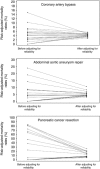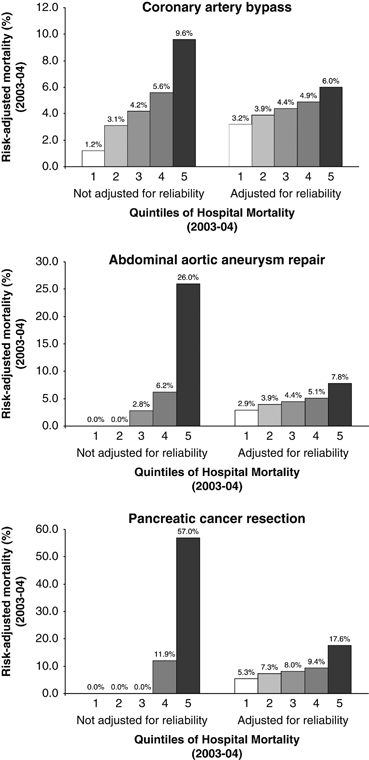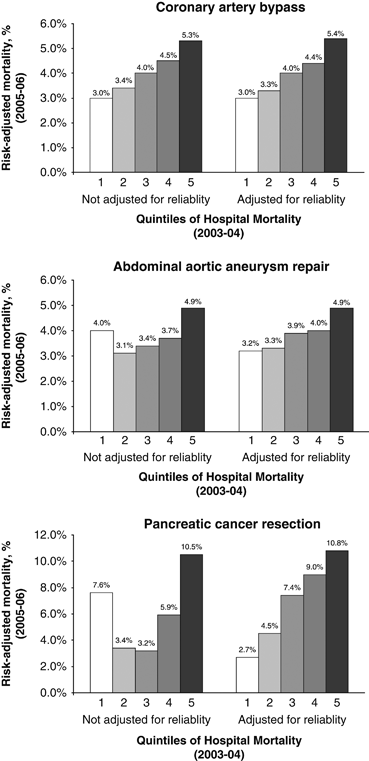Ranking hospitals on surgical mortality: the importance of reliability adjustment
- PMID: 20722747
- PMCID: PMC2976775
- DOI: 10.1111/j.1475-6773.2010.01158.x
Ranking hospitals on surgical mortality: the importance of reliability adjustment
Abstract
Objective: We examined the implications of reliability adjustment on hospital mortality with surgery.
Data source: We used national Medicare data (2003-2006) for three surgical procedures: coronary artery bypass grafting (CABG), abdominal aortic aneurysm (AAA) repair, and pancreatic resection.
Study design: We conducted an observational study to evaluate the impact of reliability adjustment on hospital mortality rankings. Using hierarchical modeling, we adjusted hospital mortality for reliability using empirical Bayes techniques. We assessed the implication of this adjustment on the apparent variation across hospitals and the ability of historical hospital mortality rates (2003-2004) to forecast future mortality (2005-2006).
Principal findings: The net effect of reliability adjustment was to greatly diminish apparent variation for all three operations. Reliability adjustment was also particularly important for identifying hospitals with the lowest future mortality. Without reliability adjustment, hospitals in the "best" quintile (2003-2004) with pancreatic resection had a mortality of 7.6 percent in 2005-2006; with reliability adjustment, the "best" hospital quintile had a mortality of 2.7 percent in 2005-2006. For AAA repair, reliability adjustment also improved the ability to identify hospitals with lower future mortality. For CABG, the benefits of reliability adjustment were limited to the lowest volume hospitals.
Conclusion: Reliability adjustment results in more stable estimates of mortality that better forecast future performance. This statistical technique is crucial for helping patients select the best hospitals for specific procedures, particularly uncommon ones, and should be used for public reporting of hospital mortality.
© Health Research and Educational Trust.
Figures



References
-
- Agency for Healthcare Research and Quality (AHRQ). 2008. “Inpatient Quality Indicators (IQI) Composite Measure Workgroup Final Report, March 2008” [accessed on March 5, 2010]. Available at http://www.qualityindicators.ahrq.gov/downloads/iqi/AHRQ_IQI_Workgroup_F.... - PubMed
-
- Birkmeyer JD, Siewers AE, Finlayson EV, Stukel TA, Lucas FL, Batista I, Welch HG, Wennberg DE. Hospital Volume and Surgical Mortality in the United States. New England Journal of Medicine. 2002;346(15):1128–37. - PubMed
-
- Center for Medicare and Medicaid Services (CMS). 2010. “Hospital Compare Website” [accessed on March 5, 2010]. Available at http://www.hospitalcompare.hhs.gov.
-
- Dimick JB, Staiger DO, Baser O, Birkmeyer JD. Composite Measures for Predicting Hospital Mortality with Surgery. Health Affairs. 2009;28(4):1189–98. - PubMed
Publication types
MeSH terms
Grants and funding
LinkOut - more resources
Full Text Sources
Medical

